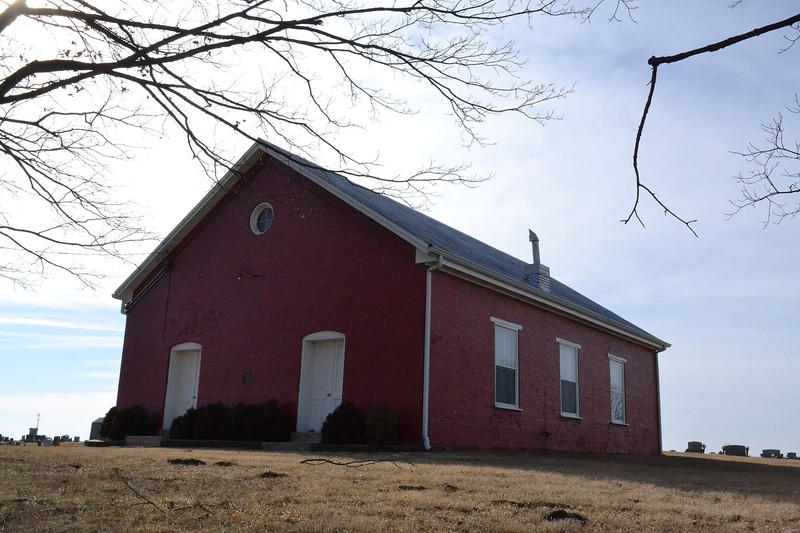Pleasant Ridge United Baptist Church
Introduction
Text-to-speech Audio
Pleasant Ridge United Baptist Church, Platte County's oldest Baptist church and one of the first three Baptist church buildings constructed in the county, was built in 1844 by a Missionary Baptist branch of the larger Hard-Shell Baptist denomination. Pleasant Ridge also stands among the oldest rural church buildings of all denominations in northwest Missouri. Its ridgetop setting adjacent to Pleasant Ridge Cemetery speaks to the church's significance within the community during the mid-nineteenth century. The cemetery is also the resting place of Mary Owens, a woman who declined Abraham Lincoln's marriage proposal.
Images
Pleasant Ridge United Baptist Church

Backstory and Context
Text-to-speech Audio
Baptists arose as one of the most prominent Protestant denominations on the Missouri frontier as ministers catered their services and ministries to frontier life. Baptists first appeared in Missouri as early as the first decade of the nineteenth century, not long after Lewis and Clark passed through western Missouri. They entered Platte County in 1837 after the Platte Purchase transpired, which displaced Native Americans and allowed White settlers to take their place. Two Baptist branches materialized: Old School/Hard-Shell and Missionary Baptists.
The Missionary Baptists erected Pleasant Ridge United Baptist Church on land provided by four slave-owning ex-Southerners, including one with a connection to Abraham Lincoln. After the community conducted three meetings in a log schoolhouse near the home of John W. Vineyard (one of four men who donated land), they formally organized the church with Reverend Albert Peter Williams as its leader (and considered its founder). Vineyard's land supplied the clay for the bricks used in the building's thick walls in 1844. The straightforward, unpretentious design of Pleasant Ridge Church speaks to the informal nature of churches on the Missouri frontier. However, the congregation maintained its simple style even as populations grew in western Missouri as it transitioned from rural, frontier land to an increasingly urban environment.
John Vineyard's brother, Jesse, married Mary Owens, who previously declined Abraham Lincoln's marriage proposal. The Lincoln connection has given the adjacent Pleasant Ridge Cemetery, established by the church in 1848, national appeal as it serves as the final resting place for Mary Owens Vineyard (and Jesse). They are buried roughly one hundred feet from the front of the church. Owens is said to have declined Lincoln's proposal in 1837 because she felt he lacked "gentlemanly qualities," so she instead married Jesse Vineyard; the couple moved from Kentucky to Weston sometime after they married in 1841.
Cite This Entry
Powers, Mathew. "Pleasant Ridge United Baptist Church." Clio: Your Guide to History. May 2, 2023. Accessed April 6, 2025. https://theclio.com/tour/2690/1
Sources
Beach, Thomas J. and Roger Maserang. "Pleasant Ridge United Baptist Church." mostateparks.com. 2002. https://mostateparks.com/sites/mostateparks/files/Pleasant%20Ridge%20United%20Baptist%20Church.pdf.
Combs, H. Jason, "Early settlement of a frontier community: The Platte Purchase, 1836–1850" ETD collection for University of Nebraska - Lincoln. 2000.
"Mary Owens." Kentucky Historical Society. Accessed April 30, 2023. https://apps.legislature.ky.gov/LegislativeMoments/moments08RS/17_web_leg_moments.htm.
Weiser, Kathy "Weston, Missouri – The Town That Refused to Die." Legends of America. January 2022. https://www.legendsofamerica.com/mo-weston/.
By 25or6to4 - Own work, CC BY-SA 4.0, https://commons.wikimedia.org/w/index.php?curid=66020875

